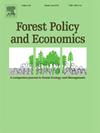在坚实的土地上建房?(In)挪威和芬兰木材建筑政策内的协调
IF 3.8
2区 农林科学
Q1 ECONOMICS
引用次数: 0
摘要
增加木材的使用是减少建筑排放的一种潜在方法。然而,它的通过取决于连贯和协调良好的政策支持。本文考察了挪威和芬兰的政策如何在各部门和各级治理中保持一致或不一致。我们调查政策的一致性和协调如何塑造芬兰和挪威木结构建筑政策的发展和实施。本文章由计算机程序翻译,如有差异,请以英文原文为准。
Building on solid ground? (In)Coordination within Norwegian and Finnish wood construction policies
Increased use of wood represents a potential way to reduce emissions from construction. However, its adoption depends on coherent and well-coordinated policy support. This paper examines how policies in Norway and Finland align, or fail to align, across sectors and levels of governance. We investigate how policy consistency and coordination shape the development and implementation of wood construction policies in Finland and Norway.
Drawing on literature on innovation policy sustainability transitions, and policy mixes, we analyse the consistency and coordination of goals, strategies, and instruments across policy domains and governance levels. The analysis is based on policy documents and interviews in both countries.
Both countries have promoted wood construction for decades, leading to innovation and the adoption of new solutions, but with varying levels of policy integration and commitment. In both cases, fragmentation across policy fields and limited vertical integration have hampered more transformative change. Horizontal coordination has been hindered by fragmented ministerial ownership, while vertical coordination is challenged by differences in local capacity and priorities, and a lack of stronger national level requirements.
This paper contributes to sustainability transitions research by offering a comparative analysis of how policy consistency and coordination shape wood construction policies in two forest-rich countries. It shows that fragmented responsibilities, weak regulatory direction, and limited vertical and horizontal coordination hinder the realisation of wood's decarbonisation potential. Strengthening policy alignment and institutional coordination is essential to enable wood to play a larger role in low-carbon construction transitions.
求助全文
通过发布文献求助,成功后即可免费获取论文全文。
去求助
来源期刊

Forest Policy and Economics
农林科学-林学
CiteScore
9.00
自引率
7.50%
发文量
148
审稿时长
21.9 weeks
期刊介绍:
Forest Policy and Economics is a leading scientific journal that publishes peer-reviewed policy and economics research relating to forests, forested landscapes, forest-related industries, and other forest-relevant land uses. It also welcomes contributions from other social sciences and humanities perspectives that make clear theoretical, conceptual and methodological contributions to the existing state-of-the-art literature on forests and related land use systems. These disciplines include, but are not limited to, sociology, anthropology, human geography, history, jurisprudence, planning, development studies, and psychology research on forests. Forest Policy and Economics is global in scope and publishes multiple article types of high scientific standard. Acceptance for publication is subject to a double-blind peer-review process.
 求助内容:
求助内容: 应助结果提醒方式:
应助结果提醒方式:


